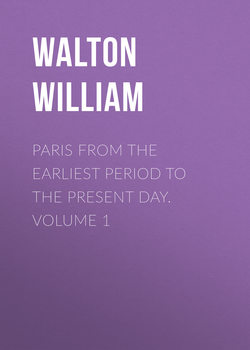Paris from the Earliest Period to the Present Day. Volume 1

Реклама. ООО «ЛитРес», ИНН: 7719571260.
Оглавление
Walton William. Paris from the Earliest Period to the Present Day. Volume 1
INTRODUCTION
INTRODUCTION. GALLO-ROMAN AND PRE-MEDIÆVAL. PERIODS
THE COURT AND THE. UPPER CLASSES
THE BOURGEOIS. AND THE LOWER CLASSES
Отрывок из книги
COTOCIA, says that somewhat inexact geographer, Strabo, "is the city of the Parisii, who dwell along the river Seine, and inhabit an island formed by the river." Ptolemy, who has been thought to have been somewhat better informed concerning the Parisii than with regard to any of the other small tribes of Gaul, calls their capital Lucotecia; but both they and their town appear for the first time in history fifty-three years before the birth of Christ, when Cæsar, in his Commentaries, relates, himself, that he summoned a general assembly of the Gauls at Lutetia, the capital of the Parisii. At this date, he was already master of the greater part of the country now called France. More than four hundred years later, Julian, surnamed the Apostate, nephew of Constantine the Great, after having passed more than two years in this city, which he called "his dear Leucetia," was proclaimed emperor here by his soldiers, who refused to obey the orders of Constantius and return to the East. It is surmised by the scholars that the imperial author of the Misopogon adopted this form of the name of the town on the Seine through an affectation of deriving it from the Greek, in which language he wrote, and, as is still evident in those of his works which have survived, in a style remarkably pure.
Lutetia, of which the modern French make Lutèce, is supposed to have been derived from the Celtic louk-teih, which signified the place of morasses; and the name of the Parisii from the Celtic par, a species of boat, and gwys, in composition ys, man, whence parys, boatmen,—these islanders being supposed to have been skilful navigators. But they are said to have called themselves Loutouchezi,—that is to say, a residence in the midst of the waters. Other etymologists cast doubts upon all these deductions, and the matter is not very important. The early Parisians were one of the smallest of the Gaulish tribes, and preferred the islands to the mainland as a safer place of residence; they were surrounded by the Carnutes, Senones, and other, stronger people whose names have not been perpetuated. Of their ten islands and sand-banks, which were preserved until late in the Middle Ages, there are now only two remaining, the Ile Saint-Louis and Ile de la Cité. The ancient town, like the modern one, lay in the centre of a "tertiary" basin, about sixty-five mètres, or two hundred and ten feet, above the level of the sea, broken here and there by low hills. The modern historian, Duruy, quotes Strabo as finding a proof of divine providence in the fortunate configuration of the soil of Gaul; and that writer testifies that the whole country was inhabited, even in the marshes and woods. "The cause of this is, however, rather a dense population than the industry of the inhabitants. For the women there are both very prolific and excellent nurses, while the men devote themselves rather to war than to husbandry."
.....
A still more important architectural feature of the ancient city was the great aqueduct which supplied the baths of the palace on the river, its fountains and those of the populous quarter around it. The waters of three or four small streams to the south of the capital were united and conveyed in a channel, lined with cement, 19,100 mètres in length, which traversed the slopes of the hills on the eastern side of the Bièvre, and remains of which have been found at various points. To cross the valley and the stream, an aqueduct was constructed on arches at the locality which took the name of Arcueil, and where some of the masonry is still preserved in modern construction, "this aqueduct being some four hundred mètres long and fifty (?) high." It is computed that a supply of twenty-four cubic mètres of water was furnished every twenty-four hours. Remains of other and smaller aqueducts have been discovered at various points in the city. At Passy, surrounding the present Trocadéro, there were springs of mineral waters, which were conveyed to the city by terra-cotta pipes, passing along the banks of the Seine. In 1781, in the gardens of the Palais-Royal, were discovered the remains of great basins which are supposed to have been the piscines of the hygienic baths. Remains of Roman aqueducts have been found at various other localities in France, at Nîmes, at Lyons, at Metz, etc., and that over the Gard is still standing in part.
Among the bridges constructed by the Gauls, Cæsar mentions that of Melun on the Seine; one on the Allier, near Vichy; that of Genabum (Orléans), and that of Lutetia, over the larger arm of the Seine, on the site of the present Pont Notre-Dame. Of that over the Allier and of the Parisian one, some of the ancient piles have been found in the bed of the rivers.
.....